#electrically erasable programmable read only memory
Explore tagged Tumblr posts
Text
https://www.futureelectronics.com/p/semiconductors--memory--RAM--eeprom--i2c-interface-protocol/cat24c64wi-gt3-onsemi-8463176
Random Access Memory, what is an EEPROM, programmable EEPROM manufacturers, ROM
CAT24C64 Series 64 Kb (8K X 8) 1.8 - 5.5 V I2C CMOS Serial EEPROM - SOIC-8
#RAM#EEPROM#I2C Interface Protocol#CAT24C64WI-GT3#onsemi#Random Access Memory#programmable EEPROM manufacturers#ROM#EEPROM microchip programming#EEPROM memory chip#flash EEPROM#electrically erasable programmable read only memory
1 note
·
View note
Text
Consumer Electronics Serial EEPROM Market Growth Analysis, Market Dynamics, Key Players and Innovations, Outlook and Forecast 2025-2032
Global Consumer Electronics Serial EEPROM Market Size Projected to Reach USD 895 Million by 2032 at 6.1% CAGR
According to new market research, the global consumer electronics serial EEPROM market was valued at USD 589 million in 2024 and is projected to reach USD 895 million by 2032, growing at a Compound Annual Growth Rate (CAGR) of 6.1% during the forecast period (2025-2032). Growth is driven by increasing demand for non-volatile memory in smartphones, IoT devices and automotive electronics, along with technological advancements in miniaturization.
Download FREE Sample Report: Consumer Electronics Serial EEPROM Market Sample
What are Serial EEPROMs?
Serial EEPROM (Electrically Erasable Programmable Read-Only Memory) refers to non-volatile memory chips that store configuration data and firmware parameters in electronic devices. These low-power integrated circuits maintain data without power, serving critical functions in consumer electronics including smartphones (accounting for 38% of demand), wearables, smart TVs and IoT devices. Available in densities from 16Kbit to 2Mbit, serial EEPROMs enable byte-level rewriting with over 1 million write cycles, making them ideal for storing frequently updated device settings.
Key Market Drivers
1. Smart Device Proliferation
With over 6.8 billion smartphone users worldwide and the average smart home containing 25 connected devices, demand for reliable configuration memory has surged. Smartphone manufacturers particularly favor serial EEPROMs for their ultra-compact sizes (under 3mm package footprints) and minimal power consumption (below 1mA active current), which are critical for battery-powered devices. Automotive applications are emerging as another strong driver, where EEPROMs store calibration data for infotainment systems and ADAS components across temperature ranges from -40°C to +125°C.
2. IoT Expansion
The Internet of Things (IoT) boom, with 29 billion connected devices projected by 2030, represents a massive growth opportunity. Serial EEPROMs serve as fundamental components in IoT nodes, storing unique device identifiers, network parameters and calibration data. Smart meters alone are expected to drive 18% annual demand growth as utilities worldwide upgrade infrastructure, with EEPROMs preferred over battery-backed SRAM due to decade-long data retention.
Market Challenges
Despite strong growth projections, the market faces several obstacles. Competition from NOR flash memory has intensified in the 1Mbit+ density range, with flash prices declining approximately 15% annually since 2020. Semiconductor supply chain disruptions have extended lead times beyond 26 weeks for some configurations, forcing OEMs to either maintain large inventories or redesign products around available components. Security limitations also pose challenges as devices store more sensitive data, requiring suppliers to enhance encryption capabilities in next-generation products.
Emerging Opportunities
Several promising trends are reshaping the market landscape. The wearable technology sector expects over 1 billion annual shipments by 2028, creating demand for ultra-thin EEPROM packages below 1mm thickness. Augmented reality headsets present another key opportunity, requiring high-reliability memory for calibration data. Regional markets show strong potential too - smart city initiatives across Middle Eastern nations and agricultural IoT adoption in South America demonstrate the technology's expanding applications beyond traditional consumer electronics.
Regional Market Insights
Asia-Pacific dominates with 60% global production share, driven by China's electronics manufacturing hub and Japan's leadership in automotive-grade components.
North America leads in innovation with premium applications, benefiting from the CHIPS Act's $52 billion semiconductor funding.
Europe shows strong demand for automotive and industrial applications, with stringent GDPR regulations driving secure memory requirements.
Emerging markets in Latin America and Africa present growth potential as smartphone penetration increases and local electronics manufacturing expands.
Competitive Landscape
STMicroelectronics holds 18% market share with comprehensive memory solutions for smartphone and automotive applications.
Microchip Technology follows with 15% share, strengthened by its $3.2 billion acquisition of Microsemi to enhance secure memory offerings.
Chinese manufacturers including Fudan Microelectronic are gaining traction through aggressive pricing in the 128Kbit-512Kbit range, though quality concerns persist in budget segments.
Market Segmentation
By Density:
Below 64Kbit (Legacy applications)
128Kbit-256Kbit (Mainstream smartphones)
512Kbit-1Mbit (Automotive/IoT)
Above 2Mbit (High-end applications)
By Application:
Smartphones (38% share)
Wearables (Fastest growing)
Automotive Electronics
Smart Home Devices
By Interface:
I2C (Legacy systems)
SPI (High-speed applications)
Microwire (Niche industrial)
Report Scope & Offerings
This comprehensive analysis provides:
Market size projections through 2032 with 2024 as base year
Competitive analysis of 12 major players including STMicroelectronics, Microchip, ON Semiconductor and Renesas
Segmentation breakdowns by density, application, interface and region
Technology trend analysis including packaging innovations like WLCSP
Download FREE Sample Report: Consumer Electronics Serial EEPROM Market Sample
View Full Report: Consumer Electronics Serial EEPROM Market - Detailed Research
visit more reports :
https://controlc.com/d6743c9ehttps://justpaste.it/i1z1fhttps://notejoy.com/corporate-financial-modelling-market-growth-analysis-market-dynamics-key-players-and-innovations-outlook-and-forecast-2025-2032-46764dhttps://pastelink.net/lxxc2r1thttps://www.rumorcircle.com/blogs/131198/Corporate-Financial-Modelling-Market-Growth-Analysis-Market-Dynamics-Key-Playershttps://hasster.com/blogs/newhttps://iamstreaming.org/siddheshkapshikar/blog/10529/corporate-financial-modelling-market-growth-analysis-market-dynamics-key-players-and-innovations-outlook-and-forecast-2025-20https://sidintelmarketresearch.hashnode.dev/corporate-financial-modelling-market-growth-analysis-market-dynamics-key-players-and-innovations-outlook-and-forecast-2025-2032https://manage.wix.com/dashboard/feeb7ef3-a212-4275-a860-fdd6d8a9ee22/blog/posts?status=%5B%7B%22id%22%3A%22PUBLISHED%22%2C%22name%22%3A%22Published%22%7D%5D&selectedColumns=col-thumbnail%2Ccol-post%2Ccol-published%2Ccol-views%2Ccol-comments%2Ccol-likes%2Ccol-categories%2Ccol-tags%2Ccol-spacer
About Intel Market Research
Intel Market Research delivers actionable insights in technology and infrastructure markets. Our data-driven analysis leverages:
Real-time infrastructure monitoring
Techno-economic feasibility studies
Competitive intelligence across 100+ countries Trusted by Fortune 500 firms, we empower strategic decisions with precision. International: +1(332) 2424 294 | Asia: +91 9169164321
Website: https://www.intelmarketresearch.com
Follow us on LinkedIn: https://www.linkedin.com/company/intel-market-research
0 notes
Text

Chiunque possieda un dispositivo cellulare ha avuto a che fare con le schede SIM, ossia con quelle piccole tessere in plastica dotate di microchip che permettono di effettuare telefonate, inviare SMS, utilizzare la connessione internet della propria offerta mobile. Non tutti però ne conoscono la storia e sanno, ad esempio, che la primissima tipologia prodotta era grande quanto una carta di credito. Nel corso del tempo, le loro dimensioni si sono ridotte sempre di più, adattandosi prima ai cambiamenti apportati ai telefoni cellulari e poi alla comparsa di nuove tipologie di dispositivi che sfruttano la tecnologia cellulare per connettersi alla rete. Oggi, a fianco alle schede fisiche, si trovano inoltre quelle digitali, note come e-sim e incorporate nei dispositivi. Ancora più pratiche, permettono di cambiare rapidamente operatore ed eliminano il rischio di smarrimento. Se vuoi saperne di più, scopri i vantaggi dell'e-sim su siti specializzati. Che cosa sono le schede SIM “SIM” è l’acronimo si “Subscriber Identity Module” e viene utilizzato per indicare quelle piccole schede dotate di microchip che, una volta inserite in un dispositivo cellulare, permettono di associare il dispositivo al gestore di telefonia mobile, al piano tariffario e all’offerta scelti, e di utilizzare la rete mobile. I chip delle SIM contengono dati criptati indispensabili per l’identificazione dell’utente e della scheda stessa; in particolare, hanno in memoria l’IMSI (International Mobile Subscriber Identity), ossia il numero dell’abbonato, l’ICCID, il numero di serie univoco che identifica la scheda, e chiavi crittografate. Oltre a questo, essendo degli EEPROM (Electrically Erasable Programmable Read-Only Memory), permettono di memorizzare contatti e SMS. Le SIM possono essere spostate da un dispositivo a un altro senza perdita di dati e informazioni. Le origini La prima scheda SIM ha fatto la sua comparsa negli anni Novanta, quando è stato introdotto il GSM (Global System for Mobile Communications) e i telefoni cellulari hanno iniziato, poco alla volta, a diffondersi. Prodotta dalla Giesecke+Devrient, una società tedesca che si occupa di tecnologie di sicurezza, era molto più grande rispetto a quelle nate negli anni successivi, tanto da somigliare a una carta di credito, e la sua capacità di memoria permetteva di memorizzare pochissimi contatti e sms. Fu proprio una di queste schede che venne utilizzata, il primo luglio 1991, dall’operatore Finlandese Radiolinja per consentire la prima telefonata GSM su rete commerciale, la quale venne effettuata dal primo ministro finlandese Harri Holkeri e dal vice sindaco della città di Tampere Kaarina Suonio. SIM sempre più piccole Non trascorse molto tempo prima che le dimensioni delle schede SIM iniziassero a ridursi. In particolare, appena cinque anni dopo, nel 1996, comparvero le prime Mini SIM (2FF). Le Micro SIM (3FF) apparvero pochi anni dopo, nel 2003, e furono seguite, a distanza di nove anni, dalle Nano SIM (4FF). Per finire, nel 2016, con la comparsa delle Embedded SIM, meglio note come eSIM, queste schede dalla lunga storia si trasformano completamente e passano dal formato fisico a quello digitale, aprendo la strada a nuove possibilità di sviluppo. L'evoluzione tecnica: quando ogni millimetro conta La riduzione delle dimensioni delle SIM non è stata una semplice questione estetica. Dietro ogni nuovo formato si nasconde una vera sfida ingegneristica che ha accompagnato l'evoluzione dei nostri dispositivi mobili. Quando nel 1996 arrivarono le Mini SIM, con i loro 25 x 15 millimetri, rappresentavano già una rivoluzione rispetto ai "mattoncini" da 85 x 54 mm delle origini. Ma il vero cambiamento arrivò con gli smartphone. Chi ricorda il primo iPhone sa bene che utilizzava ancora le Mini SIM, ma già con l'iPhone 4 del 2010, Apple fece una scelta coraggiosa: passare alle Micro SIM. Una decisione che fece storcere il naso a molti utenti dell'epoca, costretti a "tagliare" le proprie SIM per adattarle al nuovo formato. La corsa alla miniaturizzazione raggiunse l'apice nel 2012 con le Nano SIM. Appena 12,3 x 8,8 millimetri: praticamente solo il chip dorato circondato da una sottile cornice di plastica. Anche qui fu Apple, con l'iPhone 5, a fare da apripista, seguita rapidamente da tutti gli altri produttori. Chi ha mai provato a maneggiare una Nano SIM sa quanto sia facile perderla: basta un movimento sbagliato e sparisce nel nulla, spesso finendo negli angoli più impensabili della casa. Ma perché questa ossessione per le dimensioni ridotte? La risposta sta nell'evoluzione dei nostri dispositivi. Ogni millimetro risparmiato significava più spazio per batterie più grandi, fotocamere migliori, componenti più sofisticati. I progettisti hanno letteralmente lottato per ogni frazione di spazio, trasformando i nostri telefoni in piccoli computer sempre più potenti. Quando la sicurezza diventa digitale Mentre le SIM diventavano sempre più piccole, cresceva la loro importanza dal punto di vista della sicurezza. Non parliamo solo di proteggere i nostri messaggi o le telefonate, ma di veri e propri portafogli digitali. Oggi la nostra SIM è molto più di una semplice tessera per telefonare: è la chiave d'accesso ai nostri conti bancari, ai servizi di pagamento contactless, alle app di autenticazione a due fattori. Gli hacker lo sanno bene, e non è un caso che negli ultimi anni si siano moltiplicati i tentativi di SIM swapping: una tecnica in cui i criminali riescono a trasferire il nostro numero su una SIM di loro proprietà, impossessandosi di fatto della nostra identità digitale. Per questo motivo, le nuove generazioni di SIM integrano sistemi di crittografia sempre più sofisticati, con algoritmi a 128 bit che renderebbero fiera qualsiasi agenzia di intelligence. Le eSIM: la rivoluzione che non tutti vedono Ed eccoci arrivati al presente: le eSIM. Se le avete mai utilizzate, sapete già di cosa parliamo. Se non le conoscete, immaginatevi di poter cambiare operatore telefonico senza dover andare in negozio, senza aspettare il corriere, senza il rischio di perdere la microscopica Nano SIM. Tutto si risolve con qualche tap sullo schermo. Le eSIM sono arrivate nel 2016, ma hanno impiegato anni per diffondersi davvero. Apple le ha introdotte con l'Apple Watch Series 3, e la logica era cristallina: come si fa a infilare una SIM fisica in un orologio? La soluzione era integrarla direttamente nel processore. Da lì il passo verso gli smartphone è stato naturale, anche se non tutti gli operatori hanno accolto l'innovazione a braccia aperte. Perché questa resistenza? Semplice: le eSIM danno molto più potere ai consumatori. Con una SIM tradizionale, cambiare operatore significa andare in negozio, aspettare, compilare moduli. Con le eSIM, bastano pochi minuti e qualche clic. Non tutti gli operatori sono entusiasti di questa facilità, che potrebbe tradursi in clienti più "volubili". Ma i vantaggi vanno ben oltre la comodità. Chi viaggia spesso per lavoro sa quanto possa essere frustrante dover comprare SIM locali in ogni paese, o pagare costi di roaming esorbitanti. Con le eSIM, si può attivare un piano dati locale direttamente dall'aeroporto, spesso a prezzi molto più convenienti. Aziende come Airalo o Holafly hanno costruito interi business model su questa possibilità. L'Internet delle Cose: miliardi di dispositivi connessi Ma il vero campo di battaglia delle eSIM non sono i nostri smartphone, bensì l'Internet delle Cose. Pensate a una fabbrica con migliaia di sensori distribuiti, a una flotta di auto connesse, a contatori intelligenti sparsi per una città. Gestire fisicamente le SIM di tutti questi dispositivi sarebbe un incubo logistico. Con le eSIM, tutto cambia. Un'azienda può attivare remotamente la connettività di migliaia di dispositivi, monitorare i consumi, cambiare operatore se necessario, il tutto da un'unica dashboard. Non è fantascienza: succede già oggi. Le auto Tesla, ad esempio, utilizzano eSIM per ricevere aggiornamenti software via etere, trasformando ogni veicolo in uno smartphone su quattro ruote. Anche il settore sanitario sta sperimentando soluzioni innovative. Dispositivi medici impiantabili dotati di eSIM possono trasmettere costantemente dati vitali ai medici, permettendo diagnosi precoci e interventi tempestivi. Pacemaker, defibrillatori, monitor glicemici: tutti potenzialmente connessi grazie a questa tecnologia. Il futuro che ci aspetta Mentre scriviamo, ingegneri in tutto il mondo stanno già lavorando sulla prossima evoluzione: le iSIM. L'idea è semplice quanto rivoluzionaria: integrare completamente la funzionalità SIM nel processore principale del dispositivo. Niente più chip dedicati, niente più spazio occupato, consumi energetici ridotti al minimo. Parallelamente, la ricerca si sta spingendo verso territori inesplorati come la crittografia quantistica. Può sembrare roba da film di fantascienza, ma non lo è. Con l'avvento dei computer quantistici, gli attuali sistemi di sicurezza potrebbero diventare obsoleti nel giro di pochi anni. Le SIM del futuro dovranno essere pronte a questa sfida. Un impatto che va oltre la tecnologia Dietro questa evoluzione tecnologica si nasconde una trasformazione sociale profonda. Le SIM hanno democratizzato la comunicazione in modi che solo vent'anni fa sembravano impensabili. In paesi come il Kenya, i servizi di mobile banking basati su SIM hanno permesso a milioni di persone di accedere per la prima volta a servizi finanziari, bypassando completamente il sistema bancario tradizionale. La storia delle SIM è tutt'altro che finita. Anzi, stiamo probabilmente assistendo solo ai primi capitoli di una rivoluzione che renderà la connettività ancora più pervasiva, intelligente e accessibile. Dal mattoncino da carta di credito del 1991 alle eSIM di oggi, il viaggio è stato straordinario. Ma quello che ci aspetta promette di essere ancora più affascinante. Read the full article
0 notes
Text
EEP ROM is some masterful typography. It's cute and technically accurate!
See at first we had mask ROMs: this is where you have a chip that's designed from the start to only have some specific data on it. That's why it's Read Only Memory: it's memory, but you can only read it. This is what, like, NES games were built on: the game is on the ROM chip, and can't be changed.
Then someone figured out you could make the chip so that it starts out blank, then you can program it once (like burning a CD-R), so we called these Programmable ROMs: PROMs.
And then another clever engineer worked out how to make them re-erasable, by using ultraviolet light that causes the bits to weaken. You have to take out the chip, expose it in a special box (you can't just have a flashlight, because UV light will give you skin cancer and sunburns on your eyes), then program it and put it back in. But hey, it's erasable and reusable now! This is how a lot of games were developed for cartridge consoles: you'd have a special cartridge that has exposed chips, which you program and put back in the console to test. This new erasable and programmable ROM was obviously called the Erasable Programmable ROM, or an EPROM.
But then a very clever trick was figured out: if you use quantum mechanical effects you can trap charge in a tiny cell and get it out using quantum tunneling, which means you can erase it in-situ! Now you have a reusable (for a while) rewritable chip, so it was called Electrically Erasable Programmable Read Only Memory: EEPROM!
But by putting a space in it, they made it an EEP ROM, which is a much cuter name.
BTW EEPROMs are what flash memory grew out of: this is a 1985 SD card.

993 notes
·
View notes
Text
Price: [price_with_discount] (as of [price_update_date] - Details) [ad_1] Brand new and high quality EEPROM stands for electrically erasable programmable read only memory. It is a secondary storage device that once written (programmed) can hold data even when the power is removed. If you need more storage for your project, or you want to learn how to use EEPROM, then this module is designed for you. It supplies an extra 256k byte for your project. You only need simply wire them via I2C. Size: 3.7x 1.7cm 1 x AT24C256 256K Serial EEPROM Data Storage Module Onboard 8P-chip carrier, can support AT24C256 series chips; Pin power supply, on-board power indicator; on-board pull-up resistor for I2C communications required ; AT24C256 I2C Interface Memory Module 8P chip seat, installation of AT24C256 chip [ad_2]
0 notes
Text
𝟐𝟒𝐂𝟏𝟎𝟐𝟒 𝟏𝐌 𝐛𝐢𝐭 𝐒𝐞��𝐢𝐚𝐥 𝐈𝟐𝐂 𝐁𝐮𝐬 𝐄𝐄𝐏𝐑𝐎𝐌 𝐈𝐂 (𝐃𝐈𝐏-𝟖 𝐏𝐚𝐜𝐤𝐚𝐠𝐞)

https://qr.ae/p2E1s7
24C1024 1 Mbit Serial I2C Bus EEPROM IC (DIP-8 Package) The 24C1024 is a 1 Mbit (128 KB) serial EEPROM IC (Electrically Erasable Programmable Read-Only Memory) that supports the I2C (Inter -Integrated Circuit) uses in a compact DIP-8 housing. This storage device provides reliable, non-volatile storage of small amounts of data such as configuration settings, calibration parameters or user data logs, making it ideal for embedded systems and low-power applications. The 24C1024 features a flexible memory organization that allows the user to access and store data in 8-bit (byte) or 32-byte pages, enabling efficient data management. The 24C1024 operates over a wide voltage range of 2.5V to 5.5V and is highly compatible with various microcontrollers and digital systems. It supports standard I2C communication speeds of up to 400 kHz in fast mode, ensuring fast reads and writes. The EEPROM offers high durability with over 1 million write/erase cycles and a data retention period of up to 100 years, making it suitable for long-term storage in applications that require frequent updates.
Features :-Wide operating voltage, low-power modes Bi- Directional Data Transfer ProtocolSchmitt trigger, filtered inputs for noise reduction
0 notes
Text
0 notes
Text
Semiconductor Chips Explained: Different Types and Their Uses
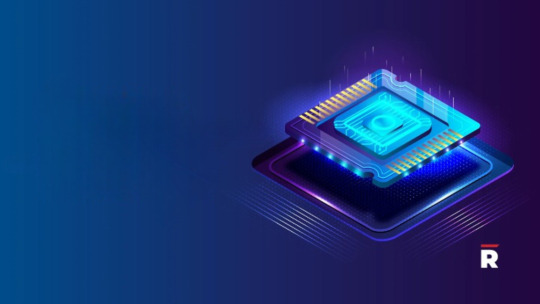
In today’s fast-paced technological landscape, there is a growing demand for faster and more efficient devices. This need, however, brings a significant challenge: balancing cost and energy consumption while enhancing the performance and functionality of electronic gadgets.
Introduction to Semiconductor Chips
Semiconductor chips are crucial in this regard. The global semiconductor market is projected to reach $687 billion by 2025, showcasing the transformative impact of these chips across various sectors, from computers and smartphones to advanced AI systems and IoT devices. Let's delve deeper into this billion-dollar industry.
What Is A Semiconductor Chip?
A semiconductor chip, also known as an integrated circuit or computer chip, is a small electronic device made from semiconductor materials like silicon. It contains millions or even billions of transistors, which are tiny electronic components capable of processing and storing data.
These chips are the backbone of modern technology, found in a vast array of electronic devices including computers, smartphones, cars, and medical equipment. Manufacturing semiconductor chips involves a complex, multi-step process that includes slicing silicon wafers, printing intricate circuit designs, and adding multiple layers of components and interconnects. Leading companies in the semiconductor industry include Samsung, TSMC, Qualcomm, Marvell, and Intel.
Types of Semiconductor Chips
Memory Chips
Function: Store data and programs in computers and other devices.
Types:
RAM (Random-Access Memory): Provides temporary workspaces.
Flash Memory: Stores information permanently.
ROM (Read-Only Memory) and PROM (Programmable Read-Only Memory): Non-volatile memory.
EPROM (Erasable Programmable Read-Only Memory) and EEPROM (Electrically Erasable Programmable Read-Only Memory): Can be reprogrammed.
Microprocessors
Function: Contain CPUs that power servers, PCs, tablets, and smartphones.
Architectures:
32-bit and 64-bit: Used in PCs and servers.
ARM: Common in mobile devices.
Microcontrollers (8-bit, 16-bit, and 24-bit): Found in toys and vehicles.
Graphics Processing Units (GPUs)
Function: Render graphics for electronic displays, enhancing computer performance by offloading graphics tasks from the CPU.
Applications: Modern video games, cryptocurrency mining.
Commodity Integrated Circuits (CICs)
Function: Perform repetitive tasks in devices like barcode scanners.
Types:
ASICs (Application-Specific Integrated Circuits): Custom-designed for specific tasks.
FPGAs (Field-Programmable Gate Arrays): Customizable after manufacturing.
SoCs (Systems on a Chip): Integrate all components into a single chip, used in smartphones.
Analog Chips
Function: Handle continuously varying signals, used in power supplies and sensors.
Components: Include transistors, inductors, capacitors, and resistors.
Mixed-Circuit Semiconductors
Function: Combine digital and analog technologies, used in devices requiring both types of signals.
Examples: Microcontrollers with ADCs (Analog-to-Digital Converters) and DACs (Digital-to-Analog Converters).
Manufacturing Process of Semiconductor Chips
Semiconductor device fabrication involves several steps to create electronic circuits on a silicon wafer. Here’s an overview:
Wafer Preparation: Silicon ingots are shaped and sliced into thin wafers.
Cleaning and Oxidation: Wafers are cleaned and oxidized to form a silicon dioxide layer.
Photolithography: Circuit patterns are transferred onto wafers using UV light and photoresist.
Etching: Unwanted material is removed based on the photoresist pattern.
Doping: Ions are implanted to alter electrical properties.
Deposition: Thin films of materials are deposited using CVD or PVD techniques.
Annealing: Wafers are heated to activate dopants and repair damage.
Testing and Packaging: Finished wafers are tested, diced into individual chips, and packaged for protection.
Conclusion
Semiconductor chips are fundamental to the functionality of nearly every electronic device we use today. They have revolutionized technology by enabling faster, smaller, and more powerful devices. While the semiconductor industry has fueled job creation and economic growth, it also faces challenges related to sustainability and environmental impact. As we continue to push the boundaries of innovation, ethical practices are essential to ensure semiconductors remain vital to our modern world and shape our future.
0 notes
Text
What is an Arduino
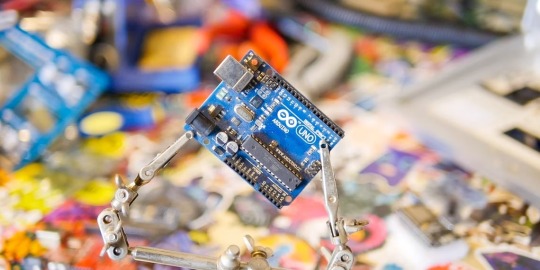
In the 21st century, do you dare to believe in a world without electronic products? Our existence is intricately interwoven with these technological marvels – from the indispensable smartphones and computers to the assistance of digital companions and the convenience of smart homes. Yet, if we momentarily cast aside the realm of cutting-edge precision electronics, we find ourselves embracing the humble yet vital realm of simple circuits. While the realms of artificial intelligence and machine learning continue to shape our imaginations more than our daily realities, instances of manually operated signal stations and traditional air conditioning units still grace our surroundings. But what craftsmanship goes into fashioning these fundamental electronic pathways that usher ease into our lives? Crafting electronic circuits is, without a doubt, a complex endeavor.
Even if one is an ardent electronics enthusiast, a comprehensive grasp of the intricate workings remains elusive without the hands-on creation of electronic circuits from the ground up. As the scope of a specific project or circuit expands, so does the labyrinthine nature of its intricacies. It's worth noting, though, that an avenue exists to temper the labyrinth's complexity – harnessing a platform that furnishes the foundational functionalities of an electronic circuit. Enter Arduino, a revered platform revered by electronics aficionados for a multitude of compelling reasons.
What is an Arduino?
Here is a brief introduction of the following what is Arduino: At its core, Arduino stands as an expansive canvas of electronic possibilities, generously embracing the quintessential functions that underpin electronic circuits. Here, the symphony of connectivity unfurls, allowing an assembly of diverse peripherals to harmonize and execute tasks with finesse. In essence, Arduino encapsulates an open-source electronic haven primed for exploration.
A cardinal facet of Arduino's allure lies in its unshackled open-source nature, fostering an environment of shared knowledge and collaborative growth. This is further complemented by a coding methodology of elegant simplicity, rendering the platform a captivating playground for novices and connoisseurs of electronics alike.
For instance, envisage the desire to craft a temperature sensor or illuminate the path with a light sensor. In this realm, simplicity reigns supreme. A mere amalgamation of the sensor, primed for perception, and the display unit, poised to unveil results, culminates in a fundamental pairing. The pièce de résistance comes to fruition through the finesse of code crafting. With judicious scripting, the display metamorphoses into a window of actuality, faithfully reflecting the sensed parameter's essence. Behold, an orchestra of technology, elegantly conducted by the Arduino's guiding baton.
Arduino Frame
Arduino finds its foundation in a microcontroller firmly rooted in the Harvard architecture paradigm. Within this architecture, a clear demarcation separates the program code and the data fueling its execution, each ensconced in distinct memory realms. Propelled by this architecture, Arduino emerges as a versatile canvas embellished with an array of I/O pins catering to the ebb and flow of input and output. Adorning this canvas, a select ensemble of pins dons the mantle of PWM output, akin to an analog brushstroke capable of bestowing nuanced control—whether it be taming the tempo of a motor or casting a gentle twilight over an LED's luminance.
In the realm of memory orchestration, Arduino dons the cap of EEPROM, or Electrically Erasable Programmable Read-Only Memory, facilitating seamless program storage and facile deletion, all orchestrated through the intuitive Arduino IDE.
At the heart of Arduino's operational tapestry lies static RAM, or SRAM, an agile repository of temporary data, diligently safeguarding snippets of information during their transient tenure. The symphony of voltage is conducted by most Arduino standard boards at a pulsating 5 volts DC. Yet, the landscape diversifies within the realm of IoT and wearables, where advanced boards unfurl their wings, potentially revealing alternate power paradigms.
The picture below is the architecture of Uno (one of the Arduino boards)
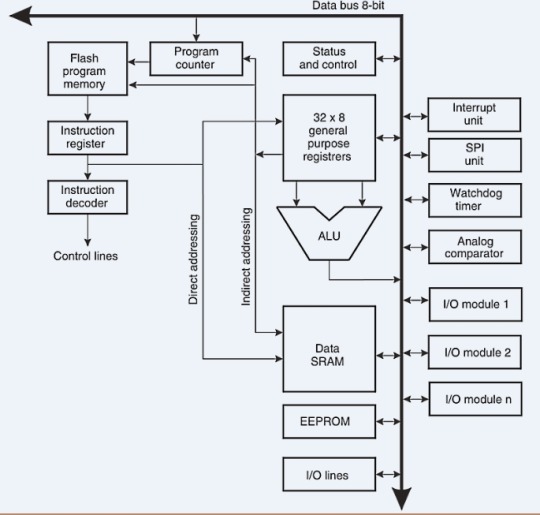
Why Arduino is popular in the maker community
Arduino's allure extends beyond its approachability and open-source nature; its prominence rests on a tapestry of factors that contribute to its widespread adoption.
Economical Access: Arduino boards emerge as budget-friendly options, encompassing an array of variants such as the Arduino Uno, Nano, and Mega. Within this pantheon, you can tailor your choice to harmonize with your requisites, all without breaking the $50 threshold.
Versatile Integration: The canvas of Arduino beckons across diverse digital landscapes, as its cross-platform prowess seamlessly interfaces with a spectrum of computer-based operating systems. This compatibility thrives across Windows, Linux, and Mac domains, knitting together harmonious interactions through dedicated Arduino applications.
Streamlined Scripting: The heart of Arduino's software beats open-source, an orchestra where seasoned programmers wield the baton of innovation, ushering in new features to amplify its capabilities. Within this ecosystem, the realm of AVR C programming intertwines with the rich tapestry of C++ libraries, forming the backbone of Arduino's code. Emboldened by conceptual clarity, the process of programming an Arduino board unfolds with an effervescent ease.
Evolving Possibilities: The allure of Arduino doesn't culminate within its board alone; a multitude of peripherals and circuits lie in wait to extend its repertoire. A Creative Commons license envelops the Arduino's programming, fanning the flames of communal creativity. This framework kindles a collaborative spirit, inspiring users to adapt, enhance, and refine the program for collective advancement.
Different Types of Arduinos
Tailoring your Arduino board selection to your project's needs unlocks a world of possibilities. Among the stalwarts, Arduino Nano and Uno stand as popular choices, while the more robust Arduino Mega caters to advanced demands. Yet, the ecosystem brims with other contenders, like Genuino 101, Esplora, M0, and MKR Zero, each fitting snugly within distinct project niches.
As Arduino's popularity surges, it permeates the realms of IoT ventures and wearable innovations. Ethernet, Yun Min, and Leonardo ETH step into the IoT spotlight, while Gemma and Lilypad Arduino don the wearable mantle. For foundational Arduino endeavors, the trusty triumvirate of Nano, Uno, and Mega holds the key.
Encompassing the core, the Arduino Nano boasts an ATmega328, boasting 32 KB of memory, with 2 KB dedicated to the bootloader, complemented by a 2 KB RAM cache. Pulsating at 16 MHz, it occupies a petite 18×45 mm PCB, featuring a constellation of 22 I/O pins, including 6 PWM-ready entities.
The Arduino Uno advances this lineage, elevating beginner-friendliness with an Atmega328P. Anchoring 14 I/O pins, 6 earmarked for PWM, Uno refines its predecessor's prowess. Nano and Uno tread similar pathways, yet Uno's superior microcontroller heralds its enhanced capacity, breathing life into an array of Arduino Uno projects.
Sitting at the pinnacle, the Arduino Mega commands attention with the ATmega2560 as its nucleus, marshaling a cavalcade of 54 I/O pins, 15 clothed in analog output or PWM capabilities. A bounteous 256 KB Flash memory, paired with 8 KB of RAM, fuels its aspirations. Locked into synchronous rhythms, both Nano and Mega clock in at 16 MHz.
Memory, RAM, and clock cycles may seem diminutive on the surface, yet within the tapestry of Arduino projects, they bear the weight of program codes and data, crafting a canvas upon which innovation thrives.
Arduino vs Raspberry Pi
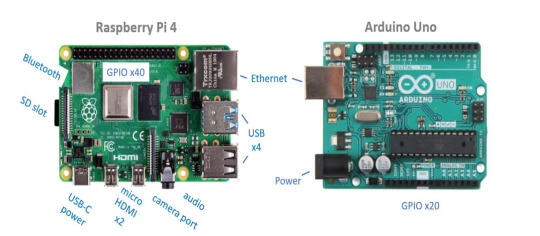
For novices, the choice ahead may seem daunting, yet I aim to simplify it for you.
Arduino, at its core, is a modest microcontroller-based development board, best suited for modest expectations. It excels in sequential tasks, adeptly handling uncomplicated assignments. However, for intricate decision-making or multitasking endeavors, Arduino may not wield optimal prowess.
Consider this: detecting human presence to illuminate a room or triggering air conditioning as temperatures rise. This exemplifies Arduino's capabilities. Yet, let not this illustration misconstrue Arduino's potential. Within its open-source community, boundless opportunities await exploration.
Enter Raspberry Pi—a diminutive computer with expansive functionalities. It tackles concurrent tasks with finesse, outstripping microcontrollers in efficiency. Although it doesn't rival our everyday PCs in might, Raspberry Pi adeptly juggles multiple responsibilities.
Picture this scenario: Regulating your air conditioner based on temperature necessitates meticulous calculations. You'll seek a month's temperature forecast, estimating air conditioner runtime and gauging electricity consumption. Should costs surge, you'll preemptively adjust settings by a couple of degrees. If orchestrating such a sophisticated system is your goal, Raspberry Pi emerges as the discerning choice.
In essence, Arduino caters to straightforward tasks, while Raspberry Pi shines in orchestrating multifaceted decision-making and swift responses, unlocking a realm of possibilities tailored to your specific aspirations.
Arduino Project
For enthusiasts seeking engaging pursuits, an array of Arduino ventures beckon. Among them, several uncomplicated yet intriguing DIY Arduino projects stand ready for your exploration:
LED Symphony: Delve into LED manipulation, orchestrating intricate light dances, including rhythmic alternations and mesmerizing breathing effects.
Ambient Guardian: Unveil the realm of temperature sensing, crafting a device to monitor and showcase ambient temperatures on an LCD canvas.
Sonic Sentinel: Evoke auditory alerts with a sound alarm, poised to resound when sound surpasses a predefined threshold.
Remote Rover: Embark on a journey of remote exploration, crafting a wireless-controlled car with Arduino and wireless modules.
Light Navigator: Harness the power of light, directing a car's movement based on ambient light intensity, a dance of photons guiding its path.
Illuminated Buttons: Master the art of control, toggling LEDs with buttons as you delve into the realm of digital inputs and outputs.
Echoes of Distance: Craft an ultrasonic marvel, fashioning a distance measurement device through ultrasonic sensors.
Greenhouse Sentinel: Cultivate your prowess, erecting a monitoring system attuned to greenhouse temperature and humidity, transmitting data to mobile devices or computers.
Pendulum Maestro: Discover the delicate balance of an inverted pendulum, acquainting yourself with sensor-driven equilibrium control.
Time's Artisan: Aspire to precision, crafting a digital clock poised to display time in its full glory, with potential for an integrated alarm feature.
0 notes
Text
What is Rom in hindi
What is Rom in hindi
What is Rom in hindi?
Types of ROM in Hindi,
Masked Read Only Memory (MROM in Hindi),
Programmable Read Only Memory (PROM in Hindi),
Erasable and Programmable Read Only Memory (EPROM in Hindi),
Electrically Erasable and Programmable Read Only Memory (EEPROM in Hindi),
FLASH ROM in Hindi,
What is Rom in hindi?
ROM, जिसका मतलब है Read Only Memory, एक मेमोरी डिवाइस या स्टोरेज medium है जो…
View On WordPress
#cache memory in hindi#difference between ram and rom memory in hindi#edo ram in hindi#EEPROM in Hindi#Electrically Erasable and Programmable Read Only Memory (EEPROM in Hindi)#EPROM in Hindi#Erasable and Programmable Read Only Memory (EPROM in Hindi)#flash memory in hindi#FLASH ROM in Hindi#Masked Read Only Memory (MROM in Hindi)#MROM in Hindi#Programmable Read Only Memory (PROM in Hindi)#prom full form in hindi#PROM in Hindi#ram and rom in hindi pdf#ROM full form#rom ka hindi meaning#ROM ka pura naam#types of dram in hindi#types of ram in hindi#Types of ROM in Hindi#what is rom in hindi
0 notes
Text
Question and Answer on Computer
Question and Answer on Computer
Q. “OS” stands for Ans: Operating System Q. The first transatlantic radio broadcast occur? Ans: 1900s Q. ‘.MOV’ extension refers usually to what kind of file? Ans: Animation/movie file Q. Which is a type of Electrically-Erasable Programmable Read-Only Memory? Ans: Flash Q. The purpose of choke in tube light is? Ans: To increase the voltage momentarily Q. ‘.MPG’ extension refers usually to…

View On WordPress
2 notes
·
View notes
Text
MEMORIA ROM
Significa memoria de solo lectura, ROM significa Read Only Memory en inglés.

Es un conjunto de chips montados en la placa madre (motherboard) que contienen instrucciones para que la computadora prepare tareas de procesamiento. Las instrucciones de la ROM son permanentes y no puedes cambiarlas, a menos que quites los chips de ROM de la tarjeta principal y los reemplaces en otro conjunto.
Contiene los programas que inicializan la computadora, efectúan el diagnóstico del sistema y controlan las actividades de entrada y salida de bajo nivel. ROM es una memoria no volátil, es decir, a medida que se apaga la fuente de alimentación del aparato, la ROM no pierde los datos almacenados en su chip.
Además contiene un pequeño conjunto de instrucciones que dicen a la computadora cómo llegar a las unidades de disco y buscar el sistema operativo. Cuando enciendes tu PC, recuerda que la RAM está vacía. La unidad central de procesamiento ejecuta una serie de pasos siguiendo las instrucciones almacenadas en la ROM. Estos pasos se llaman proceso de inicialización, algunos pasos de este proceso se almacenan de manera permanente en la ROM.
El programa almacenado en la ROM se llama BIOS llamado Sistema Básico de Entrada/Salida (Basic Input/Output System).
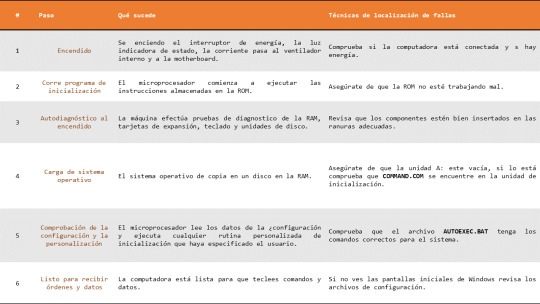
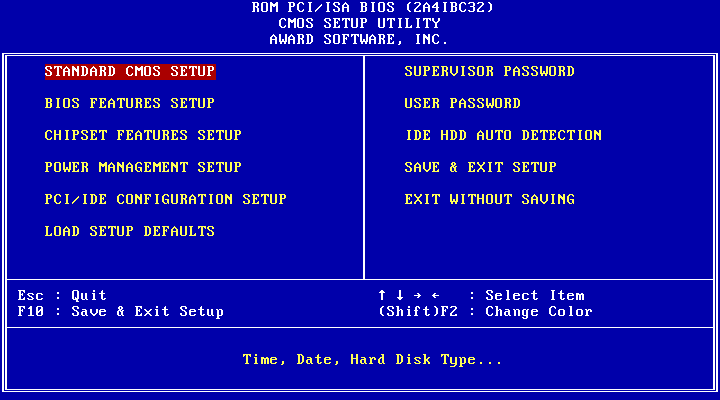
Tipos de ROM
Las memorias ROM han evolucionado gradualmente desde memorias fijas de solo lectura hasta convertirse en memorias que pueden programarse y reprogramarse.

ROM: Las primeras ROM se fabricaron utilizando un procedimiento que escribe directamente la información binaria en una placa de silicona mediante una máscara. Este procedimiento es obsoleto actualmente.
PROM: Las memorias PROM (Programmable Read Only Memory, memoria programable de solo lectura), fueron desarrolladas a fines de la década de los 70 por Texas Instruments. Consisten en chips que comprimen miles de fusibles (o diodos) capaces de "quemarse" mediante un dispositivo denominado programador ROM, aplicando un alto voltaje (12V) a las cajas de memoria a marcar. Los fusibles quemados corresponden a 0 y los demás a 1.
EPROM: Las memorias EPROM (Erasable Programmable Read Only Memory, memoria programable y borrable de solo lectura), son memorias PROM que se pueden borrar. Estos chips disponen de un panel de vidrio que deja entrar los rayos ultravioleta. Cuando el chip es sometido a rayos ultravioleta de una determinada longitud de onda, se reconstituyen los fusibles, lo que implica que todos los bits de memoria vuelven a 1. Por esta razón, este tipo de PROM se denomina borrable.
EEPROM: Las memorias EEPROM (Electrically Erasable Programmable Read Only Memory, memoria programable de solo lectura borrable el��ctricamente) también son memorias PROM borrables, pero a diferencia de estas, se pueden borrar mediante una sencilla corriente eléctrica, es decir, incluso si se encuentran dentro del ordenador.
Existe una variante de estas memorias, conocida como memoria flash (también Flash ROM o Flash EPROM). A diferencia de las memorias EEPROM clásicas, que utilizan 2 o 3 transistores por cada bit a memorizar, la memoria EPROM Flash utiliza un solo transistor. Además, la memoria EEPROM puede escribirse y leerse palabra por palabra, mientras que la Flash únicamente puede borrarse por páginas (el tamaño de las páginas disminuye constantemente).
Por último, la memoria Flash es más densa, lo que implica que pueden producirse chips que contengan cientos de megabytes. De esta manera, las memorias EEPROM son preferibles a la hora de tener que memorizar información de configuración, mientras que la memoria Flash se utiliza para código programable (programas de IT).
Ventajas de la ROM
Se utiliza para almacenar software de firmware.
Es mucho más barato que la RAM y también está disponible en un tamaño más grande (capacidad).
Sus datos no cambian, solo se pueden leer.
No podemos agregarle ningún dato nuevo aunque queramos, porque en él los datos son programados por el programador una sola vez.
ROM es más confiable que la memoria RAM de la computadora porque los datos en RAM solo duran mientras haya alimentación en la computadora.
Implica programas e instrucciones muy reflexivos porque no podemos cambiarlo una y otra vez.
3 notes
·
View notes
Text
Electrically Erasable Programmable Read Only Memory Market : Segmented by Application and Geography Trends, Growth and Forecasts 2026

Electrically erasable programmable read only memory (EEPROM) is a non-volatile memory used in computers, smartphones, and electronic devices to store small volumes of data. Increasing demand for high speed, highly scalable memory devices, and low power consuming devices are major factors driving growth of electrically erasable programmable read only memory market. Increasing adoption of high speed internet and Internet of Things (IoT) devices have propelled the demand for high speed memory devices, which are expected to fuel growth of electrically erasable programmable read only memory market in IOT devices.
Download PDF Brochure @ https://www.coherentmarketinsights.com/insight/request-pdf/650
On the basis of geography, electrically erasable programmable read only memory market is segmented into North America, Europe, Asia Pacific, Latin America, Middle East, and Africa. Asia Pacific holds the dominant position in the global electrically erasable programmable read only memory market and is projected to retain its dominance throughout the forecast period. Significant growth witnessed by consumer electronics and automotive industry in turn fuels growth of market in major economies such as China and India. For instance, electronics market in India accounted for US$ 36.2 billion in 2016, from US$ 31.6 billion in 2015, and is projected to reach US$ 104 billion by 2020.
Major players operating in electrically erasable programmable read only memory market include Atmel Corporation, Hitachi, Ltd., Infineon Technologies AG, Intersil, Linear Technology Corporation, Macronix International, Maxwell Technologies, Microchip Technology, Mitsubishi Electric Corporation, NXP Semiconductors N.V., ON Semiconductor, Renesas Electronics Corporation, ROHM Semiconductor, Samsung Electronics, Seiko Instruments Inc., STMicroelectronics, and Winbond Electronics Corporation.
Browse Complete Report @ https://www.coherentmarketinsights.com/insight/request-customization/650
#Electrically Erasable Programmable Read Only Memory Market#Electrically Erasable Programmable Read Only Memory Market Size#Electrically Erasable Programmable Read Only Memory Market Share
0 notes
Text
𝟐𝟒𝐂𝟏𝟎𝟐𝟒 𝟏𝐌 𝐛𝐢𝐭 𝐒𝐞𝐫𝐢𝐚𝐥 𝐈𝟐𝐂 𝐁𝐮𝐬 𝐄𝐄𝐏𝐑𝐎𝐌 𝐈𝐂 (𝐃𝐈𝐏-𝟖 𝐏𝐚𝐜𝐤𝐚𝐠𝐞)
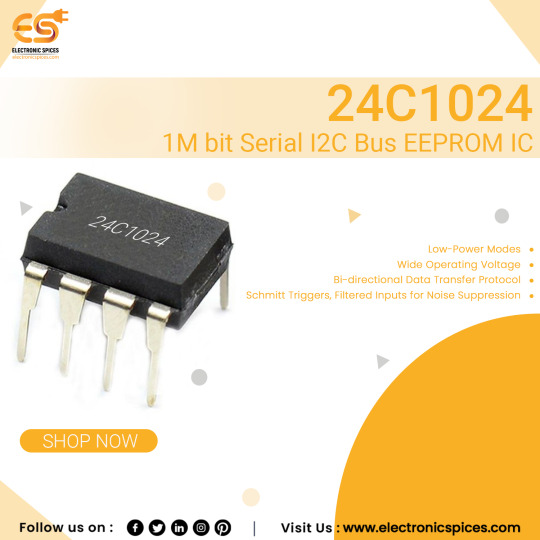
24C1024 1 Mbit Serial I2C Bus EEPROM IC (DIP-8 Package) The 24C1024 is a 1 Mbit (128 KB) serial EEPROM IC (Electrically Erasable Programmable Read-Only Memory) that supports the I2C (Inter -Integrated Circuit) uses in a compact DIP-8 housing. This storage device provides reliable, non-volatile storage of small amounts of data such as configuration settings, calibration parameters or user data logs, making it ideal for embedded systems and low-power applications. The 24C1024 features a flexible memory organization that allows the user to access and store data in 8-bit (byte) or 32-byte pages, enabling efficient data management. The 24C1024 operates over a wide voltage range of 2.5V to 5.5V and is highly compatible with various microcontrollers and digital systems. It supports standard I2C communication speeds of up to 400 kHz in fast mode, ensuring fast reads and writes. The 12C EEPROM IC offers high durability with over 1 million write/erase cycles and a data retention period of up to 100 years, making it suitable for long-term storage in applications that require frequent updates.
Features :-
Wide operating voltage, low-power modes Bi- Directional Data Transfer ProtocolSchmitt trigger, filtered inputs for noise reduction.
𝐒𝐩𝐞𝐜𝐢𝐟𝐢𝐜𝐚𝐭𝐢𝐨𝐧 :-
Low-voltage Operation – 2.7 (VCC = 2.7V to 5.5V)
Voltage on Any Pin with Respect to Ground: -1.0V to +7.0V
Storage temperature: -65°C to +150°C
Operating Temperature: -55°C to +125°C
Maximum Operating Voltage: 6.25V
DC Output Current: 5.0 mA
400 kHz (2.7V) and 1 MHz (5V) Clock Rate
256-byte Page Write Mode (Partial Page Writes Allowed)
0 notes
Text
According to Nolan, the core of the control unit is a golf-ball-sized transparent "neuroplastic" sphere informally called a "pearl." Within the pearl are densely-packed microscopic filaments of neural material that are ostensibly the organic analog to the RAM (Random Access Memory) and EEPROM (Electrically Erasable Programmable Read Only Memory) of a computer chip. These filaments contain the programming and memory for the host — in effect, they are the soul of the host. The pearl is housed within the larger baseball-sized housing informally referred to as a "chestnut."
5 notes
·
View notes